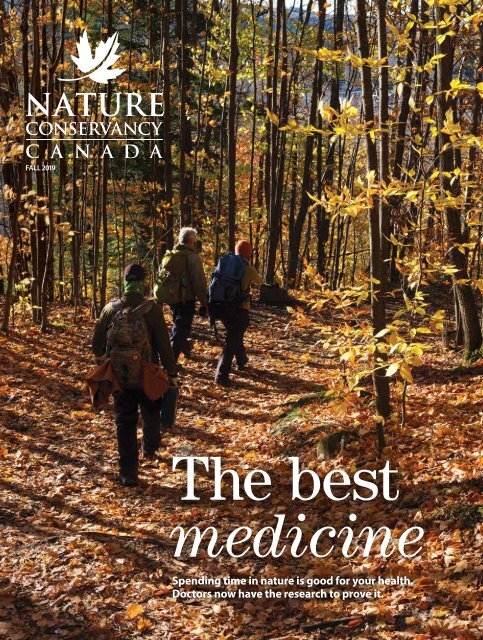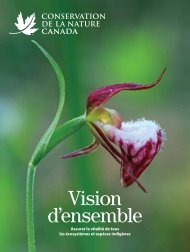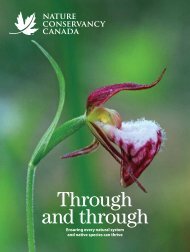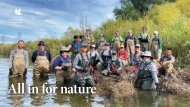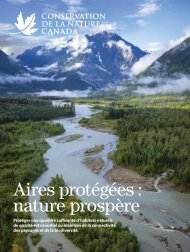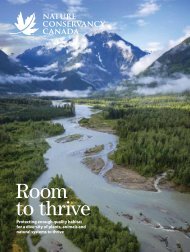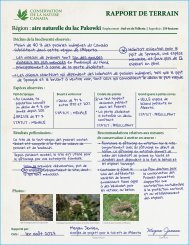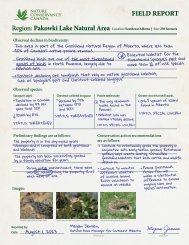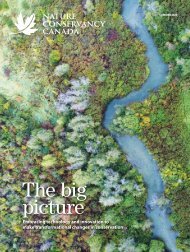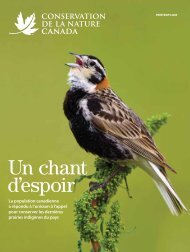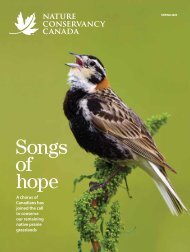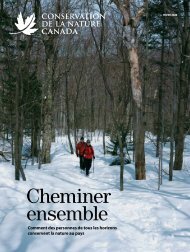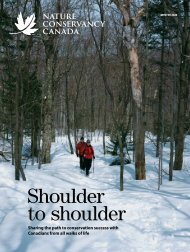NCC Magazine: Fall 2019
You also want an ePaper? Increase the reach of your titles
YUMPU automatically turns print PDFs into web optimized ePapers that Google loves.
FALL <strong>2019</strong><br />
The best<br />
medicine<br />
Spending time in nature is good for your health.<br />
Doctors now have the research to prove it.
Nature Conservancy of Canada<br />
245 Eglinton Ave. East, Suite 410<br />
Toronto, Ontario, Canada M4P 3J1<br />
magazine@natureconservancy.ca<br />
Phone: 416.932.3202<br />
Toll-free: 877.231.3552<br />
The Nature Conservancy of Canada<br />
(<strong>NCC</strong>) is the nation’s leading land<br />
conservation organization, working<br />
to protect our most important natural<br />
areas and the species they sustain.<br />
Since 1962, <strong>NCC</strong> and its partners have<br />
helped to protect 14 million hectares<br />
(35 million acres),<br />
coast to coast to coast.<br />
The Nature Conservancy of Canada<br />
<strong>Magazine</strong> is distributed to donors and<br />
supporters of <strong>NCC</strong>.<br />
TM<br />
Trademarks owned by the Nature<br />
Conservancy of Canada.<br />
FSC is not responsible<br />
for any calculations on<br />
saving resources by<br />
choosing this paper.<br />
Printed on Rolland Opaque paper,<br />
which contains 30% post-consumer<br />
fibre, is EcoLogo, Processed Chlorine<br />
Free certified and manufactured in<br />
Canada by Rolland using biogas energy.<br />
Printed in Canada with vegetable-based<br />
inks by Warrens Waterless Printing.<br />
This publication saved 29 trees and<br />
104,292 litres of water*.<br />
COVER<br />
Hikers on <strong>NCC</strong>’s Alfred-Kelly Nature<br />
Reserve, a Nature Destination in Quebec.<br />
Photo by Guillaume Simoneau.<br />
THIS PAGE<br />
Fundy National Park, New Brunswick.<br />
Photo by Zack Metcalfe.<br />
TKTKTKTKTKTKT<br />
GENERATED BY: CALCULATEUR.ROLLANDINC.COM<br />
*<br />
2 FAL <strong>2019</strong> natureconservancy.ca
FALL <strong>2019</strong><br />
CONTENTS<br />
Nature Conservancy of Canada<br />
Dear friend,<br />
TKTKTKTKTKTKT<br />
For most Canadians, the concept of a hectare may<br />
seem vague. So what would it mean if I told you that,<br />
based on a recent accounting of the total lands you<br />
have helped us conserve since 1962, our total came<br />
in at 14 million hectares (35 million acres)? That’s<br />
a big number!<br />
And how big is 14 million hectares? If you think of<br />
Canada’s geography, it’s about 25 times the size of<br />
PEI, or about four times the size of Vancouver Island.<br />
Describing those hectares in this way makes our collective<br />
efforts to conserve our country’s natural legacy<br />
much more understandable, and something in which<br />
you, as donors and partners, should take great pride.<br />
Thank you.<br />
If you’ve been a supporter of the Nature Conservancy<br />
of Canada (<strong>NCC</strong>) for some time, you may note that<br />
this represents a significant boost in our tally of total<br />
land conserved. But we didn’t get there overnight.<br />
Every number of years, <strong>NCC</strong> undertakes a review of<br />
how we measure our conservation impact. This time<br />
we more fully accounted for the lands we have directly<br />
acquired, conserved and currently steward, as well as<br />
the broader impact of our work through partnership.<br />
Your support has meant that the past several years<br />
have seen an unprecedented increase in the pace of<br />
our work, particularly in large landscape-scale projects.<br />
This includes our work to help relinquish private<br />
rights in lands (such as timber, oil and gas), thereby<br />
removing impediments to conservation. In particular,<br />
we now count the Birch River Wildland Provincial Park<br />
in Alberta (contributing to the world’s largest boreal<br />
forest protected area) and the new Tallurutiup Imanga<br />
National Marine Conservation Area in Nunavut (Canada’s<br />
largest protected area) among major projects<br />
that have benefited from our work to remove private<br />
resource rights.<br />
And so I’m sharing with you 14-million reasons to<br />
feel good about nature.<br />
Nature makes us all feel good, and in this issue of<br />
our magazine, you’ll read about why more doctors than<br />
ever before are prescribing time in nature to improve<br />
their patients’ well-being. And thanks to your belief in<br />
our mission, there are now more places for Canadians<br />
to connect with nature and boost their health.<br />
Thank you for your support of our mission,<br />
John Lounds<br />
John Lounds<br />
President<br />
natureconservancy.ca<br />
8<br />
14 16<br />
14 Back from the brink<br />
Learn how the Nature Conservancy of Canada is helping bring back species<br />
at risk of extinction.<br />
6 Ralph Wang Trail<br />
Immerse yourself in the diversity of Canada’s endangered native prairie<br />
habitat with a walk down the trail at this Nature Destination in Manitoba.<br />
7 Paddle on<br />
Former Ottawa Riverkeeper Meredith Brown explores Canada’s lakes and<br />
rivers with her handmade whitewater paddle.<br />
8 Prescribing nature<br />
For the sake of a healthy and sustainable future, time in nature is essential.<br />
Doctors now have the research to prove it.<br />
12 Greater sage-grouse<br />
Learn about a bird whose courtship dance is one of North America’s most<br />
incredible wildlife spectacles.<br />
14 Project updates<br />
Listening for the bat signal in Saskatchewan; Making Darkwoods whole in BC;<br />
PEI nature reserve donated by local family.<br />
16 Birds of a feather<br />
The Nature Conservancy of Canada’s newly appointed Weston Family senior<br />
scientist, Ryan Norris, discusses how you can get involved in conservation.<br />
18 Stories, snakes and sons<br />
Looking back on many visits to Writing-on-Stone Provincial Park in Alberta.<br />
FALL <strong>2019</strong> 3
COAST TO<br />
COAST<br />
Back<br />
from<br />
the<br />
brink<br />
The Nature Conservancy<br />
of Canada’s restoration<br />
work is helping protect<br />
endangered species and<br />
is even bringing back<br />
species at risk of extinction<br />
In May of this year, the United Nations<br />
released a Global Assessment Report on<br />
the outlook for species biodiversity worldwide.<br />
This report found that up to one million<br />
unique species are at risk of extinction due to<br />
human-related effects, such as climate change<br />
and habitat loss. The truth is, we are losing<br />
species at an alarming rate, and every day<br />
species are put at risk of disappearing from<br />
the Earth forever.<br />
That’s where you and the Nature Conservancy<br />
of Canada (<strong>NCC</strong>) come in. Efforts to conserve<br />
and restore animal and plant populations in the<br />
wild are an ongoing and important part of our<br />
conservation strategy. And while addressing<br />
the underlying causes for population decline is<br />
a crucial step, we need more habitat protection<br />
and restoration to bring these species back from<br />
the brink of extinction.<br />
Wildlife conservation efforts can take many<br />
forms — from captive breeding programs designed<br />
to boost populations to the restoration<br />
and protection of key habitats. Across Canada,<br />
species at risk are struggling to cope with the<br />
loss of native habitats, invasive species and<br />
rapidly changing climate patterns. But dedicated<br />
conservationists are working hard to restore<br />
populations and protect species biodiversity.<br />
TKTKTKTKTKTKT<br />
KEN GILLESPIE PHOTOGRAPHY/ALAMY STOCK PHOTO.<br />
4 FALL <strong>2019</strong> natureconservancy.ca
Here are six species at risk<br />
that <strong>NCC</strong> is helping to conserve<br />
Piping plover<br />
Blanding’s turtle<br />
American badger<br />
In Atlantic Canada, piping plovers nest<br />
only on sand and pebble beaches with<br />
scattered vegetation. These endangered<br />
birds require peace and quiet<br />
away from human disturbance to raise<br />
their young. In Nova Scotia, the birds<br />
breed on fewer than 30 beaches in<br />
total, and the distribution of suitable<br />
habitat is similarly sparse throughout<br />
the rest of Atlantic Canada. <strong>NCC</strong> has<br />
partnered with provincial governments,<br />
Bird Studies Canada, the Island Nature<br />
Trust, Nature NB, Intervale and other<br />
conservation organizations to identify<br />
and protect piping plover nesting<br />
beaches and clean up shoreline<br />
habitat in the Atlantic region.<br />
Blanding’s turtle is considered<br />
endangered throughout its Great<br />
Lakes and St. Lawrence ranges.<br />
In these areas, road mortality is<br />
among the biggest threats to its<br />
survival. <strong>NCC</strong> conservationists are<br />
actively engaging with the public to<br />
teach drivers how to safely stop and<br />
help turtles cross the road. With new<br />
tools such as carapace.ca, a website<br />
developed by <strong>NCC</strong> and the Province<br />
of Quebec, anyone can snap a picture<br />
of a turtle they see on the road<br />
and contribute to a citizen<br />
science database.<br />
In 2004, <strong>NCC</strong> biologists working on<br />
the Kootenay River Ranch property<br />
in central British Columbia discovered<br />
the presence of endangered<br />
American badgers. The 1,250-hectare<br />
(3,089-acre) stretch of the Upper<br />
Columbia River Valley offers<br />
a continuous grassland habitat free<br />
of roads and other human development,<br />
which so often disturb and<br />
create human-animal conflict for<br />
badger populations. This protected<br />
natural area also provides scientists<br />
with the opportunity to conduct<br />
ongoing research on the endangered<br />
species to further improve<br />
restoration efforts.<br />
SWIFT FOX: CREDIT: ROBERT HARDING/ALAMY STOCK PHOTO. ALL OTHERS: ROBERT MCCAW.<br />
natureconservancy.ca<br />
Monarch<br />
The global population of monarchs<br />
has been decreasing at a rapid rate.<br />
This is thought to be a result of habitat<br />
loss in both its wintering ground in<br />
Mexico and throughout its summer<br />
ranges in Canada and the U.S. <strong>NCC</strong> is<br />
working to restore breeding, feeding<br />
and stopover habitats across the<br />
country and is actively planting<br />
milkweed (the monarch caterpillar’s<br />
host plant) and other native wildflowers<br />
in Manitoba to improve and<br />
expand feeding and breeding habitat<br />
throughout the province. On Pelee<br />
Island in Ontario, we are restoring<br />
wetland and meadow habitat for rare<br />
and at-risk species, such as monarchs.<br />
Swift fox<br />
The swift fox represents an amazing<br />
conservation success story. Although<br />
the species was once extirpated<br />
(locally extinct) in Canada due<br />
primarily to habitat loss, in 1973<br />
a reintroduction program was<br />
launched that has seen a return of<br />
approximately 650 swift foxes to the<br />
Prairies of Alberta and Saskatchewan.<br />
As the species still faces threats from<br />
genetic isolation due to habitat<br />
fragmentation, <strong>NCC</strong>’s work to secure<br />
and steward the remaining grassland<br />
habitat that serves as linkages<br />
between the populations is vital.<br />
Plains bison<br />
An icon of the Prairies, the plains<br />
bison once thundered across much<br />
of western North America, but by the<br />
turn of the 20 th century overhunting<br />
had reduced the total population to<br />
as few as 300 individuals. Since being<br />
reintroduced to Saskatchewan’s Old<br />
Man on His Back Prairie and Heritage<br />
Conservation Area in 2003, <strong>NCC</strong> has<br />
maintained a herd of genetically<br />
pure bison on the property. <strong>NCC</strong> staff<br />
now manage the grassland prairie<br />
for grazing and keep a close eye on<br />
the health of the population.<br />
FALL <strong>2019</strong> 5
BOOTS ON<br />
THE TRAIL<br />
Burrowing owl<br />
Ralph Wang Trail<br />
Immerse yourself in the diversity of Canada’s endangered<br />
native prairie habitat at this Nature Destination in Manitoba<br />
The Ralph Wang Trail, located near<br />
Pierson, Manitoba, provides a glimpse<br />
into the past, when native prairie once<br />
stretched beyond the horizon. Today, grasslands<br />
like this are rare, as are many of the birds<br />
and plants you’ll encounter along the trail.<br />
Grasslands such as those around the<br />
Ralph Wang Trail have long been synonymous<br />
with Canada’s Prairie provinces. They provide<br />
critical stopovers for migratory birds and habitat<br />
for waterfowl and rare and endangered<br />
species, including ferruginous hawk, burrowing<br />
owl and prairie butterflies. Grasslands also<br />
protect our water, sequester and store carbon<br />
and provide a precious and sustainable source<br />
of grazing land for livestock.<br />
The Ralph Wang Trail is also a travel corridor<br />
for wildlife and makes for a good place to<br />
see deer, fox, coyote and other animals. The<br />
eastern cottonwood trees provide an oasis<br />
for songbirds, while the prairie is home to<br />
a variety of rare grassland birds.<br />
HABITAT<br />
Along the trail, the land transitions between<br />
the uplands of native mixed-grass prairie and<br />
the wet meadows of the lowlands. As the trail<br />
moves closer to the water, the vegetation<br />
changes from grasses and wildflowers to<br />
willows, sedges and prairie cordgrass.<br />
Mixed-grass prairie surrounding the trail<br />
may at first look like a field of knee-high<br />
grass, but upon closer inspection you can’t<br />
help but notice its diversity. When the snow<br />
melts, the prairie comes alive with a colourful<br />
variety of grasses and wildflowers, including<br />
a combination of drought-tolerant short-grass<br />
prairie plants and tall grass prairie plants that<br />
grow in moist soils.<br />
<strong>NCC</strong>. BURROWING OWL: ROBERT MCCAW.<br />
6 FALL <strong>2019</strong> natureconservancy.ca
Ferruginous hawk<br />
BACKPACK<br />
ESSENTIALS<br />
SPECIES TO SPOT<br />
• burrowing owl<br />
• chestnut-collared<br />
longspur<br />
• ferruginous hawk<br />
• grasshopper sparrow<br />
• LeConte’s sparrow<br />
• loggerhead shrike<br />
• monarch<br />
• moose<br />
• mule deer<br />
• sharp-tailed grouse<br />
• Sprague’s pipit<br />
FERRUGINOUS HAWK: ROBERT MCCAW. PORTRAIT: JESSICA DEEKS.<br />
COMMUNITY EFFORT<br />
In 2012, the Regional Municipality of Edward<br />
(now the Municipality of Two Borders)<br />
entered into an agreement with the Nature<br />
Conservancy of Canada (<strong>NCC</strong>) to ensure the<br />
ongoing protection of the prairie. Though<br />
the land remains municipally owned, a conservation<br />
agreement places certain restrictions<br />
on development.<br />
For almost 40 years, Ralph Wang was the<br />
reeve of the Regional Municipality of Edward.<br />
An amateur birdwatcher and with a lifelong<br />
interest in conservation, Wang worked<br />
with <strong>NCC</strong>’s Manitoba Region to set up a<br />
conservation agreement on land owned by<br />
the municipality.<br />
This area is protected and managed by<br />
the Municipality of Two Borders in cooperation<br />
with <strong>NCC</strong> and a local cattle producer.<br />
SEASON<br />
April 15 to November 15<br />
TRAIL<br />
Type: loop Difficulty: easy<br />
Round-trip distance: 1 km<br />
Surface: mowed grass<br />
DIRECTIONS<br />
From Pierson, drive west on Highway 3 for<br />
1.6 kilometres. Turn south (left) on Antler<br />
Road and proceed for 8.8 kilometres. The<br />
Ralph Wang Trail will be on the east (left)<br />
side of the road.1<br />
Nature Destinations<br />
Learn more at naturedestinations.ca<br />
Paddle on<br />
Former Ottawa Riverkeeper Meredith Brown explores<br />
Canada’s wilderness by navigating its lakes and rivers<br />
with her handmade whitewater paddle<br />
When you live in the world’s largest freshwater ecosystem, [the Great<br />
Lakes basin], you learn how to paddle! My favourite way to explore our<br />
Canadian wilderness is through the endless network of lakes and rivers<br />
that ultimately connect us to our neighbours and to our oceans. As rivers carve their<br />
path across the landscape, they meander and create patterns of rapids and pools.<br />
The rapids are my favourite — for the sounds, the earthy smell and the challenge of<br />
making it down the hydraulic patterns caused by river rocks and elevation changes.<br />
For navigating rivers, I travel by canoe with my handmade whitewater paddle. It<br />
was made using sustainably harvested, local wood by my friend Andy Convery, who<br />
is an artist, educator, canoe builder, paddle maker and wilderness guide. The paddle<br />
was a gift from my husband, Ronnie, who I also love to bring into nature with me.1<br />
natureconservancy.ca<br />
FALL <strong>2019</strong> 7
<strong>Fall</strong> at <strong>NCC</strong>’s Alfred-Kelly Nature Reserve,<br />
a Nature Destination in Quebec<br />
BY Zack Metcalfe, author and freelance writer<br />
Prescribing<br />
For the sake of a healthy and sustainable future, time in nature is essential.<br />
Doctors now have the research to prove it.<br />
TKTKTKTKTKTKT<br />
8 FALL <strong>2019</strong> natureconservancy.ca
GUILLAUME SIMONEAU<br />
It was too cold even for insects.<br />
The glassy surface of Lake Superior<br />
faithfully reflected a ruby sky as<br />
the sun rose over Ontario’s Pancake<br />
Bay Provincial Park, crisp beams<br />
of light cutting through the branches of oldgrowth<br />
maple, birch, oak, spruce and pine. The<br />
mist burned away, and birdsong swelled to<br />
fill the open chambers of this lakeside wood.<br />
I was alone.<br />
A week on the road, living out of my car<br />
and hastily erected tents, had me wound<br />
pretty tight, but here I felt calm for the first<br />
time in days, even exultant.<br />
While I wasn’t aware of it in the moment,<br />
the natural cathedral in which I stood was orchestrating<br />
profound changes in me, lowering<br />
my blood pressure and heart rate, and stemming<br />
the flow of the stress hormone cortisol.<br />
My anxieties, tribulations and ruminations<br />
were dissipating while feelings of happiness,<br />
curiosity, vitality and awe were welling up.<br />
The health benefits of time in nature,<br />
once the stuff of folk wisdom, are now the<br />
subject of medical interest. Among children,<br />
regular doses of nature have the long-term<br />
benefits of improved self-esteem, vision,<br />
body weight, attention and overall academic<br />
performance. In surgical recovery rooms,<br />
patients with windows overlooking greenery<br />
are less dependent on painkillers. Having 10<br />
more trees on your city block improves selfperceived<br />
health, equivalent to being seven<br />
years younger, or $10,000 a year richer.<br />
These findings and others are no longer<br />
theoretical, speaking to a phenomenon as<br />
powerful as it is mysterious.<br />
Continued, next page >><br />
nature<br />
TKTKTKTKTKTKT<br />
natureconservancy.ca<br />
FALL <strong>2019</strong> 9
Students at Trent University explore<br />
the school’s natural areas and<br />
conduct research on the benefits<br />
of time in nature.<br />
Relatedness<br />
Lisa Nisbet, associate professor at Trent<br />
University’s department of psychology in<br />
Ontario, has focused her career on this<br />
subject. While we walked the edge of campus<br />
in early June, she expounded on the benefits<br />
of even 15 minutes in natural settings.<br />
Nisbet’s research has focused on how time<br />
in nature influences our treatment of nature,<br />
examining what she calls nature relatedness.<br />
In simple terms, nature relatedness is how<br />
much a person appreciates nature as a whole<br />
— not just the cute or scenic parts — and to<br />
what extent they understand the complex relationships<br />
tying it all together. Holding<br />
swamps and sunny beaches in equal regard for<br />
their unique diversity means you’re on the<br />
right track. Regarding yourself as a small piece<br />
of an enormous ecological puzzle, better still.<br />
To determine a person’s level of relatedness,<br />
Nisbet and her colleagues established<br />
the Nature Relatedness Scale: a test of 21<br />
items, which gives a score between 1 and 5,<br />
with 1 representing poor nature relatedness.<br />
To date, this scale has been translated into<br />
over a dozen languages, adopted by a number<br />
of environmental organizations (including the<br />
Nature Conservancy of Canada [<strong>NCC</strong>] with its<br />
Nature Quiz program – naturequiz.ca), and<br />
applied to over 10,000 people, from office<br />
workers to conservation professionals. The<br />
average Canadian scores around three on<br />
the Nature Relatedness Scale.<br />
What Nisbet found is that the more time<br />
people spend in nature, the higher their nature<br />
relatedness tends to be, and the more<br />
We all know that when we go out into<br />
nature, we feel calmer, less stressed,<br />
happier, but now we have numbers to<br />
back these feelings up.<br />
likely they are to engage in environmentally<br />
conscious behaviours. And the more time we<br />
spend in nature, the more likely we are to<br />
want to protect it.<br />
“It’s very difficult for the average person to<br />
be an environmental citizen unless they have<br />
an intrinsic motivation to protect nature,” she<br />
explains. “If you don’t see or understand the<br />
consequences of pouring paint down the drain<br />
or putting pesticides on your lawn, you’re just<br />
not going to take the appropriate action.”<br />
“We need to make nature a habit,” she adds.<br />
Best medicine<br />
Ten years ago, Dr. Melissa Lem wrote her first<br />
prescription for nature to a young man battling<br />
attention deficit disorder. She was confident<br />
in the demonstrated benefits, but was<br />
still hesitant to prescribe something so radically<br />
new, fearing it would sound “crunchy<br />
granola.” All the same, it was well-received.<br />
Since then, she’s become an advocate<br />
for nature prescriptions, championing them<br />
at conferences, during guided tours through<br />
the provincial parks of BC and in her family<br />
medicine practice. Lem prescribes time in<br />
nature for depression, stress, attention<br />
disorders, even concussions; 30 minutes<br />
a pop, two hours a week, minimum.<br />
“We all know that when we go out into<br />
nature, we feel calmer, less stressed, happier,<br />
but now we have numbers to back these feelings<br />
up,” she says.<br />
Lem sits on the board of the Canadian<br />
Association of Physicians for the Environment<br />
(cape.ca), an organization whose mission is to<br />
better human health through environmental protection.<br />
It’s thanks to doctors such as Lem that<br />
such things will eventually find their way into<br />
medical textbooks, and that green prescriptions<br />
will become commonplace in medical clinics.<br />
“Doctors and nurses are consistently rated<br />
among the five most trusted professionals<br />
in Canada,” Lem says. “When we say something,<br />
patients listen. If we could get health<br />
professionals to mobilize and prescribe nature<br />
more frequently, I think that would be<br />
quite powerful.”<br />
Just such an endeavour is brewing at the<br />
South Georgian Bay Community Health<br />
TAYLOR ROADES.<br />
10 FALL <strong>2019</strong> natureconservancy.ca
TAYLOR ROADES.<br />
Centre, near Wasaga Beach, Ontario. Ruth<br />
McArthur is a nurse with the District Health<br />
Authority and board member of the Wasaga<br />
Beach Healthy Community Network, the<br />
group ultimately responsible for crafting<br />
these prescriptions. McArthur says the<br />
size and scope of the program is fundingdependent,<br />
but she and her colleagues<br />
expect to be able to write their first<br />
prescriptions sometime this fall.<br />
As they have thus far been imagined, these<br />
prescriptions will come hand-in-hand with<br />
maps of accessible parks near Wasaga Beach,<br />
and perhaps park passes from Ontario Parks<br />
(who is a partner with the health network).<br />
The group hopes to raise awareness among<br />
health centre clients and other health care<br />
practitioners about the benefits of spending<br />
time in nature.<br />
Coming home<br />
In July, I met Tyler Coady, a young man of 33,<br />
strong and very well-spoken, who greeted me<br />
with a joke and a smile in downtown Charlottetown,<br />
PEI. Coady suffers from post-traumatic<br />
stress disorder (PTSD) — the consequence<br />
of a roadside bomb he encountered<br />
during his military service in Afghanistan.<br />
“One of the things I missed the most being<br />
overseas was green space,” says Coady.<br />
“PTSD disrupts pretty well every aspect of<br />
your life,” he explains. It’s plagued him with<br />
unwelcome flashbacks and constant, crippling<br />
anxiety. Coady initially withdrew from society.<br />
Counseling, medication and peer support<br />
were integral to his ongoing recovery, but so<br />
was his purchase of a small farm and regular<br />
hikes through its wilder corners.<br />
While in busy areas, Coady must actively<br />
suppress his PTSD symptoms. When he’s in<br />
nature, however, staying calm is no work at all.<br />
Whatever hold nature has on the human mind,<br />
it’s especially pronounced in people like Coady.<br />
Making use of a master’s degree in military<br />
psychology, he’s been coordinating peer support<br />
groups for other Island veterans with mental<br />
injuries, helping them find peace in nature.<br />
The Island Nature Trust, a valued <strong>NCC</strong><br />
partner, is among the oldest private land trusts<br />
in Canada, protecting over 1,600 hectares<br />
(over 4,000 acres) of PEI wilderness since its<br />
founding in 1979. Recognizing the special<br />
need among veterans for nature, they offered<br />
Coady the use of their largest protected<br />
area — replete with forests, wetlands, trails<br />
and old access roads for those struggling<br />
with mobility.<br />
“There is broad recognition now that we’re<br />
only going to protect what we love. Trying<br />
to compartmentalize people and the rest of<br />
nature doesn’t work,” says Megan Harris,<br />
executive director of the Island Nature<br />
Trust. “We are not separate from nature,<br />
and there are things we need in nature.<br />
Those needs are sometimes compounded<br />
when our minds have been tested in the<br />
extreme, as with veterans.”<br />
Nature For All<br />
For its part, <strong>NCC</strong> has created a number<br />
of programs to increase the connections between<br />
people and nature. Its Conservation<br />
Volunteers program empowers Canadians to<br />
participate in hands-on conservation, restoration<br />
and research on their properties across<br />
the country. <strong>NCC</strong> also has close to 40 Nature<br />
Destinations (naturedestinations.ca), which<br />
offer access to a suite of properties ready to<br />
receive the eager hiker, amateur birder or<br />
nature novice.<br />
“We’re pleased to share these select sites<br />
to help Canadians of all levels of ability and<br />
experience to connect with nature,” said<br />
Erica Thompson, <strong>NCC</strong>’s director of engagement.<br />
“The ‘great outdoors’ brings families<br />
and friends together, and can provide a<br />
greater personal appreciation of nature and<br />
the importance of caring for these special<br />
places. My recent visit to the Gaspé Peninsula,<br />
Quebec, including <strong>NCC</strong>’s Nature Destination<br />
at Pointe Saint-Pierre, reconfirmed to me<br />
the importance of spending time in nature,<br />
unplugging from all devices and celebrating<br />
the curiosity and inspiration that comes<br />
from time well-spent outside.”<br />
<strong>NCC</strong> is encouraging people to explore<br />
its Nature Destinations, both on the ground<br />
and online, in all 10 provinces. Visitors can<br />
experience a variety of activities, including<br />
hiking, walking, canoeing, kayaking, photography<br />
and wildlife appreciation. From<br />
Victoria to St. John’s, there are a blend of<br />
natural areas that are accessible in both<br />
urban and rural areas for people to take<br />
advantage of.<br />
<strong>NCC</strong> has several goals with its Nature<br />
Destinations program. It hopes to get people<br />
outside so they can enjoy the physical and<br />
mental health benefits of being active in<br />
nature. <strong>NCC</strong> also hopes that people will gain<br />
an appreciation for the ecological benefits<br />
that nature offers, such as clean air and<br />
water, and the importance of conserving<br />
nature for future generations.<br />
From indoor enthusiasts to nature lovers<br />
and everyone in between, <strong>NCC</strong> wants to<br />
make the outdoors more accessible to people.<br />
In preparation for going to one of the<br />
Nature Destinations, people are also encouraged<br />
to visit naturequiz.ca and take the<br />
six-question online Nature Quiz and receive<br />
a Nature Score, which will show how connected<br />
they are to nature. Once people<br />
receive their Nature Score, they can sign<br />
up for a virtual Nature Coach, and receive<br />
email tips for a happier, healthier life by<br />
incorporating time in the outdoors.<br />
Thompson is also a member of<br />
#NatureForAll Canada, an initiative of the<br />
International Union for Conservation of<br />
Nature, aimed at reconnecting humans with<br />
what remains of our natural heritage. The<br />
Canadian chapter is a young but growing<br />
coalition of NGOs, government departments,<br />
academics and of course <strong>NCC</strong>, bringing<br />
a diversity of disciplines to bear on this<br />
campaign of reconnection.<br />
The separation of human beings from<br />
nature has done monumental harm to mind,<br />
body and biodiversity; a point made only<br />
too clear by the people in this article. For<br />
the sake of a healthy and sustainable future,<br />
through these programs and others, finding<br />
ways to pursue nature is not just helping nature,<br />
it’s helping ourselves. Since that early<br />
morning in Pancake Bay Provincial Park,<br />
I find myself more likely to reach for hiking<br />
shoes than for Aspirin, and far less willing<br />
to spend a beautiful day indoors.1<br />
natureconservancy.ca<br />
FALL <strong>2019</strong> 11
SPECIES<br />
PROFILE<br />
Greater<br />
sage-grouse<br />
Learn about a bird whose elaborate courtship dance is<br />
one of North America’s most incredible wildlife spectacles<br />
RICK & NORA BOWERS /ALAMY STOCK PHOTO<br />
12 FALL <strong>2019</strong> natureconservancy.ca
APPEARANCE<br />
The greater sage-grouse is brownish-grey<br />
on top, and its tail is black and white.<br />
Adult males have a white band on a black<br />
breast and a collar of pointed white<br />
feathers, along with a pointed tail. Both<br />
sexes sport a black belly.<br />
Greater sage-grouse<br />
recovery project<br />
Although it was once common across the western prairie, the<br />
population of greater sage-grouse decreased by an estimated<br />
80 per cent over the past 30 years. Today, fewer than 250 wild<br />
greater sage-grouse remain in southeastern Alberta and southwestern<br />
Saskatchewan.<br />
The birds were designated as endangered in Canada under the<br />
Species at Risk Act, primarily due to native grassland habitat loss,<br />
fragmentation and degradation due to oil and gas exploration<br />
and the conversion of grassland to cropland.<br />
RANGE<br />
This species is found in western North<br />
America in areas where sagebrush grows,<br />
including southeastern Alberta and<br />
southwestern Saskatchewan. The bird is<br />
extirpated (locally extinct) from BC.<br />
DANCING GROUNDS<br />
Each spring, greater sage-grouse congregate<br />
in areas called leks. Here, males<br />
display elaborate courtship dances for<br />
females. As the males strut, they inflate<br />
and deflate their throat sacs with a<br />
popping sound, throwing their heads<br />
back, spreading their wings and fanning<br />
out their tails.<br />
SAGEBRUSH<br />
Greater sage-grouse populations are<br />
limited to sagebrush grasslands. In the<br />
summer, sagebrush makes up more than 60<br />
per cent of the adult greater sage-grouse’s<br />
diet, along with flowers and buds from<br />
forbs. In the winter, sagebrush makes up<br />
its entire diet.<br />
HELP OUT<br />
You can help protect habitat for greater<br />
sage-grouse. To find out how, visit<br />
giftsofnature.ca.<br />
In 2014, the federal and provincial governments pledged<br />
funding to help protect greater sage-grouse, enabling the<br />
Calgary Zoo to begin a dedicated conservation breeding<br />
and reintroduction program.<br />
In 2016, the zoo announced the creation of Canada’s first-ever<br />
greater sage-grouse breeding facility: the Snyder-Wilson Family<br />
Greater Sage-Grouse Pavilion. Since then, the zoo has established<br />
a healthy population of 54 sage-grouse that makes up the<br />
conservation breeding flock.<br />
In fall 2018, the Calgary Zoo released 66 birds at two protected<br />
locations. One of the sites, provided by Parks Canada, is in<br />
Grasslands National Park in Saskatchewan. The other is on<br />
Nature Conservancy of Canada (<strong>NCC</strong>) conservation lands in<br />
southeast Alberta.<br />
The Bell-Sage-Grouse<br />
Legacy Project<br />
Barbara Bell was a caring <strong>NCC</strong> supporter who included a gift to<br />
<strong>NCC</strong> in her Will. It was her wish that this gift contribute to a legacy<br />
for conservation while helping an endangered species to recover.<br />
With this gift, <strong>NCC</strong> has invested in a new conservation site<br />
surrounded by native grassland in prime greater sage-grouse<br />
habitat. This property will be named the Bell-Sage-Grouse<br />
Legacy Project.<br />
Barbara’s legacy will be carefully managed to support <strong>NCC</strong>’s<br />
role in habitat restoration and the ongoing stewardship of this<br />
site and of other vital prairie grassland conservation sites.<br />
The Bell-Sage-Grouse Legacy Project started as an agricultural<br />
field that had not been planted for approximately five years.<br />
In the coming years, <strong>NCC</strong> will undertake the restoration of this<br />
65-hectare (160-acre) parcel of land. This restoration work is<br />
a collaborative effort supported by the Alberta Conservation<br />
Association and Alberta Environment and Parks.<br />
<strong>NCC</strong> looks forward to this site becoming an intact parcel of native<br />
prairie that provides continuous habitat for greater sage-grouse<br />
and other native grassland species.<br />
With this investment, the impact of Barbara’s generous support<br />
will be felt across Alberta’s grasslands for generations.1<br />
natureconservancy.ca<br />
FALL <strong>2019</strong> 13
PROJECT<br />
UPDATES<br />
1<br />
Listening for bat signals<br />
SASKATCHEWAN<br />
2<br />
1<br />
THANK YOU!<br />
Your support has made these<br />
projects possible. Learn more at<br />
natureconservancy.ca/where-we-work.<br />
Listening for bats in central Saskatchewan.<br />
3<br />
Little brown myotis and northern myotis bats are both listed as endangered<br />
in Canada due to devastating population declines in eastern Canada as<br />
a result of white-nose syndrome, an introduced fungal disease.<br />
The fungus is moving west, but it has not yet been documented in Saskatchewan.<br />
As a result, there is an urgent need to determine the population status of<br />
myotis bats in Saskatchewan, as well as to determine what type of habitats they<br />
are using for different parts of their life cycle.<br />
Through acoustic surveys, the Nature Conservancy of Canada’s (<strong>NCC</strong>’s) Saskatchewan<br />
Region has been working to develop a better understanding of what bat<br />
species are found on our properties — by listening for their calls. Using an ultrasonic<br />
recording device in areas likely to be used by bats (such as waterbodies and forest<br />
trails) <strong>NCC</strong> staff record the bats’ calls as they fly around and forage for insects.<br />
The calls of each species are unique. By reviewing sonograms of the bats’ calls<br />
recorded on each property, we can determine which species are present and how<br />
active they are. To date, we have surveyed eight properties across the province<br />
and documented all eight bat species known to occur in Saskatchewan, including<br />
endangered little brown myotis and northern myotis.<br />
In summer 2018, we initiated a project to identify where little brown and northern<br />
myotis were using habitat in the aspen and mixed-wood forests of central Saskatchewan.<br />
Both species have been confirmed in the area; however, which areas<br />
and habitat types they are actually using and for what purpose (such as for day<br />
roosting or as a maternity colony) remains unclear. After catching bats with mist<br />
nets, we then attach radio transmitters to them. Bats with transmitters are tracked<br />
back to their roosting areas, which can then be identified.<br />
Both little brown myotis and northern myotis use tree cavities for roost sites,<br />
so the trees being used can be compared to others on the landscape to identify<br />
which trees are used by myotis bats. This information can help <strong>NCC</strong> tailor our<br />
management plans in the areas where these species occur to help with the<br />
species’ protection and recovery.<br />
You can also help by joining Neighbourhood Bat Watch (batwatch.ca), which<br />
aims to document and monitor bat colonies across Canada. The data collected<br />
allows scientists to track bat populations and distribution, and determine if the<br />
populations are stable or growing, or if they are in need of conservation action.<br />
Determining the age of the bat. Adult bats have a fused joint in their wing, while it is absent in<br />
juveniles. Shining a light from behind illuminates the joint and helps distinguish this feature.<br />
SARAH LUDLOW.<br />
14 FALL <strong>2019</strong> natureconservancy.ca
2<br />
Making Darkwoods whole<br />
BRITISH COLUMBIA<br />
TOP TO BOTTOM: STEVE OGLE. STEVE OGLE. YAY MEDIA AS/ALAMY STOCK PHOTO. SEAN LANDSMAN.<br />
When <strong>NCC</strong> acquired Darkwoods in 2008, we knew<br />
at the time that this major accomplishment was not<br />
truly complete. As vast as Darkwoods was (spanning<br />
over 550 square kilometres), there was a missing<br />
piece right in the heart of the conservation area.<br />
For Tom Swann, <strong>NCC</strong>’s director of strategic<br />
initiatives and major gifts, this missing piece was<br />
central to the vision of Darkwoods. He believed it<br />
was a question of when, not if, <strong>NCC</strong> would acquire<br />
the unprotected land at the core of this important<br />
conservation area.<br />
“It didn’t matter who we were talking to; as<br />
soon as we put a map of Darkwoods in front of<br />
them, they would immediately point at the hole<br />
in the middle and ask, ‘What’s that? What’s going<br />
to happen to it?’” Tom recalls.<br />
Ten years after the initial conservation of Darkwoods,<br />
the timing fell into place to make it whole,<br />
by filling the “hole” in its centre. The landowners<br />
were ready to sell the property. Thanks to a trusting<br />
relationship built over time with <strong>NCC</strong> staff,<br />
they chose to prioritize a conservation sale over<br />
other options that would have left the land open<br />
to unsustainable development opportunities.<br />
The newly conserved lands encompass most of<br />
the Next Creek watershed, which nurtures pockets<br />
of old-growth inland temperate rainforest and provides crucial habitat for grizzly bear, wolverine, elk,<br />
bull trout and other wildlife. The unique forests found here are sometimes known as snow forests,<br />
because they receive most of their moisture from the snowpack. These snow forests harbour the<br />
highest tree diversity in BC. Notably, like all of Darkwoods, this land represents a stronghold for the<br />
endangered whitebark pine.<br />
“Conserving the Next Creek watershed and expanding the Darkwoods Conservation Area presented<br />
an incredible opportunity to fulfill a conservation vision that started over a decade ago,” says Nancy<br />
Newhouse, <strong>NCC</strong>’s BC regional vice-president. “We are so grateful for all of the people and organizations<br />
who believed in this vision of creating an internationally significant conservation impact.”<br />
Learn more about the people and organizations who helped make this project happen at natureconservancy.ca/bc.<br />
3<br />
PEI nature reserve donated by local family<br />
PRINCE EDWARD ISLAND<br />
Thanks to a well-known family on PEI, <strong>NCC</strong> has conserved 91 hectares (226<br />
acres) of rare wetland and hardwood forest in Kingsboro, near Souris. The<br />
site was donated to <strong>NCC</strong> by Camilla MacPhee and her family, in memory of<br />
her late husband, Melvin MacPhee.<br />
At 13, Melvin began working in his parents’ grocery store in Souris, later<br />
called Clover Farm. In the 1980s, he developed a mall in Souris and became<br />
one of the larger local employers. He was widely regarded as a communityminded<br />
business leader. Melvin was inducted into the PEI Business Hall of Fame in 2005, and died in<br />
2010 at the age of 78.<br />
The Camilla and Melvin MacPhee Nature Reserve features a large undisturbed peat bog; a type<br />
of freshwater wetland that is rare on the Island. It also features an older-growth forest of red maple,<br />
sugar maple and yellow birch; a combination of native hardwoods that is no longer common on PEI. The<br />
area provides habitat for eastern wood-pewee, listed under Canada’s Species at Risk Act, as well as<br />
many provincially rare plants, such as herb-Robert and nodding trillium.<br />
Partner<br />
Spotlight<br />
TD Bank Group (TD) is supporting<br />
the Nature Conservancy of<br />
Canada (<strong>NCC</strong>) through its<br />
corporate citizenship platform,<br />
The Ready Commitment,<br />
as the presenting sponsor<br />
of NatureTalks.<br />
The NatureTalks Cross-Country<br />
Speaker Series visits cities across<br />
Canada, providing thoughtprovoking<br />
content and discussions<br />
led by a diverse panel of experts.<br />
As presenting sponsor, TD is<br />
supporting a large network of<br />
community leaders and socially<br />
conscious citizens who are coming<br />
together to explore and value<br />
nature as a resource, a source of<br />
inspiration and a place that<br />
sustains life.<br />
Through The Ready Commitment,<br />
TD aspires to use its business,<br />
philanthropy and people to<br />
help elevate the quality of the<br />
environment so that people<br />
and economies can thrive. This<br />
is part of its commitment to<br />
help create a more inclusive<br />
and sustainable tomorrow.<br />
TD and its national foundation,<br />
TD Friends of the Environment<br />
Foundation, have supported <strong>NCC</strong><br />
for over 30 years. From 2012 to<br />
2016, TD and <strong>NCC</strong> worked<br />
together to help protect forested<br />
areas across Canada. TD helped<br />
<strong>NCC</strong> protect more than 16,000<br />
hectares (40,000 acres) in seven of<br />
Canada’s eight forest regions. From<br />
coastal forest in British Columbia,<br />
to boreal forest in Saskatchewan,<br />
to Acadian forest in Nova Scotia,<br />
support from TD has helped <strong>NCC</strong><br />
protect important forested habitats<br />
across all 10 provinces.<br />
To learn more about TD’s<br />
commitment, visit<br />
td.com/vibrantplanet.<br />
natureconservancy.ca
FORCE FOR<br />
NATURE<br />
Birds of<br />
a feather<br />
The Nature Conservancy of Canada’s newly appointed Weston Family senior<br />
scientist, professor Ryan Norris, discusses how you can get involved in conservation<br />
MIKE FORD.<br />
16 FALL <strong>2019</strong> natureconservancy.ca
Open grassland spans the 80 hectares<br />
(200 acres) of Kent Island, New Brunswick,<br />
neighbouring Grand Manan Island in the<br />
Bay of Fundy. For 12 years each spring, you could<br />
find Ryan Norris on a patch of land occupying just<br />
300 square metres of this quaint island.<br />
ROBERT MCCAW.<br />
“I could stand in the middle of my study site and see ocean on<br />
both sides,” recalls the associate professor in the Department<br />
of Integrative Biology at the University of Guelph in Ontario.<br />
“Sometimes I would see whales go by.”<br />
Norris was there to monitor the island’s population of savannah<br />
sparrows; part of a four-decade-long, ongoing study on the population<br />
ecology of this species, originated by American ornithologist<br />
Nat Wheelwright and now facilitated by Norris and his research lab.<br />
It was here on Kent Island that Norris evolved his understanding of<br />
how migratory birds fit into the country’s larger conservation picture<br />
under the threats of climate change. Based on his research observations,<br />
Norris notes, “We’re losing birds.”<br />
“At the start of my career, I never considered myself a conservation<br />
biologist. Now, ecologists have no choice — we all need to be<br />
conservation biologists,” says Norris. As the climate rapidly changes,<br />
there is no separation between ecology (the study of species and<br />
their relationships with the environment) and conservation biology<br />
(the study of how we save species), he explains. “It’s why I’m here<br />
at the Nature Conservancy of Canada (<strong>NCC</strong>).”<br />
This spring, Norris was appointed <strong>NCC</strong>’s Weston Family senior<br />
scientist. In this role, Norris will apply conservation research to what<br />
is arguably one of the most urgent issues of our time: the protection<br />
of plants and animals and the natural habitats they need to survive.<br />
Norris will also develop and lead the new Weston Family Conservation<br />
Science Fellows Program, which will support conservation<br />
leaders of the future. The program will offer hands-on opportunities<br />
to graduate students who are studying species at risk, invasive<br />
species or effective conservation.<br />
It’s exciting for people at every<br />
level to contribute and be involved<br />
in conservation science.<br />
“I envision this program as a way to develop and mentor the next<br />
generation of ecologists,” Norris explains. “I hope it becomes a global<br />
example for training conservation leaders.”<br />
Norris brings with him his experience as an ecologist and leader<br />
in migratory bird and monarch butterfly research. He started his<br />
research lab at the University of Guelph in 2006 to focus on the effects<br />
of varying seasons on migratory and resident species, such as those<br />
found here in Canada.<br />
An effective science communicator, Norris hopes to shed light on<br />
the impacts of climate change on migratory species.<br />
“The conservation of these species depends on knowing where<br />
they go during migration and how climate change influences their<br />
Savannah sparrow<br />
success in the wild, or lack of thereof,” he<br />
says. “In my position with <strong>NCC</strong>, I hope to<br />
strengthen collaborations with academic<br />
partners, progress our knowledge on species<br />
and use this information to make evidencebased<br />
decisions about how to better conserve<br />
natural spaces across Canada.”<br />
Norris believes everyone can do their<br />
part to help protect habitat and the species<br />
that live there. The opportunities for citizen<br />
scientists to contribute to conservation<br />
efforts in Canada have never been greater.<br />
With apps like eBird and iNaturalist, the<br />
public can submit species observations<br />
to larger databases.<br />
“Public-contributed data is being used for<br />
high-level research. This information adds<br />
to the data that scientists are using to piece<br />
together information about species behaviours,<br />
habitat and migratory patterns,” he states. “It’s<br />
exciting for people at every level to contribute<br />
and be involved in conservation science.”<br />
While he has wrapped up his time on<br />
the Bay of Fundy for now to work on other<br />
research projects, Norris reflects fondly<br />
about his time on Kent Island, both professionally<br />
and personally.<br />
“I watched my daughter grow up on the<br />
island. She was five months old the first time<br />
she visited it. Now she’s six years old. It’s still<br />
one of my favourite places to be. I actually<br />
just got back from there.”1<br />
The Weston Family senior scientist position and the<br />
Weston Family Conservation Science Fellows Program<br />
are both made possible through the generosity of<br />
The W. Garfield Weston Foundation.<br />
natureconservancy.ca<br />
FALL <strong>2019</strong> 17
CLOSE<br />
ENCOUNTERS<br />
Stories, snakes and sons<br />
Chris Fisher, author, filmmaker and television host<br />
NatureTalks<br />
Chris Fisher will be<br />
a speaker at this fall’s<br />
NatureTalks events.<br />
Learn more at<br />
natureconservancy.ca/<br />
naturetalks.<br />
Driving across Alberta’s grasslands, the horizon<br />
reaches about as far as you can see. The land<br />
is flat, stretched taut over the skin of some of<br />
Canada’s best grasslands — which are among the world’s<br />
most endangered ecosystems. Travelling through this<br />
landscape in no way prepares you for your first glimpse of<br />
Writing-on-Stone Provincial Park/Áísínai’pi — a UNESCO<br />
World Heritage site. Dipping over the crest of the Milk<br />
River valley, hoodoos — the sun-bleached bones of the<br />
Prairies — become visible. This is the land of the Blackfoot<br />
people, where petroglyph tablets share stories of<br />
generations and vindicate the park’s inclusion into the<br />
UNESCO club. Just as eroding winds shaped the iconic<br />
pillars of the hoodoos, these curvaceous landforms<br />
have shaped millennia of visions.<br />
Looking back on my many visits to Writing-on-Stone,<br />
I now realize that by getting lost in this hoodoo maze as<br />
a child, I was actually finding something within myself.<br />
By spending time in places like this, the compass of my<br />
life was set to align with birds, bugs and fresh air.<br />
I recently returned to the park with my two young<br />
sons. It was my chance to help them discover something<br />
in this sacred place. Unbeknownst to us, we had<br />
pitched our tent on a highway for reptiles and amphibians.<br />
Bullsnakes, wandering gartersnakes and even a rattlesnake<br />
slithered through our site, between their upcountry<br />
hibernacula and their riverside summer grounds.<br />
Most slithered through uncelebrated, but a couple<br />
provided a showcase. We admired a yearling rattler at<br />
a distance, until it was safely moved by park staff. I later<br />
formalized introductions between my boys (plus a throng<br />
of onlookers) and a bullsnake calmly coiling in my arms.<br />
I shared information with them about the snake; but these<br />
moments are always more about feelings than facts. Feelings<br />
are our memories’ trigger.<br />
I’m proud that my sons continue to react well to every<br />
snake they meet. It’s hard to know whether they remember<br />
anything from their first intimate encounter with that<br />
bullsnake. But such moments crucially inform our character<br />
and the values upon which they are inscribed.1<br />
CORY PROULX.<br />
18 FALL <strong>2019</strong> natureconservancy.ca
What Will We Leave<br />
For Them?<br />
Invest in what matters most<br />
The Nature Conservancy of Canada's Landmark Campaign is the largest<br />
private conservation fundraising campaign in Canadian history. Reaching<br />
our target of $750 million will mean the completion of 500 conservation<br />
projects from coast to coast to coast, and the protection of the countless<br />
species that depend on this habitat.<br />
Together, we can protect Canada’s natural legacy.<br />
Donate today at LeaveYourLandmark.ca.<br />
Thank you to all of our donors for supporting the Landmark Campaign.<br />
There's still time to get involved; together, we can reach the campaign target.<br />
With your help, we will conserve more land faster, connect more Canadians<br />
to nature and inspire the next generation of conservation leaders.
Leave your<br />
YOUR<br />
VOICES<br />
Landmark<br />
Thank you for your continued support of the Landmark Campaign!<br />
The success of the Landmark Campaign would not be possible<br />
without your support. Together, we have raised over $615 million to<br />
date to conserve more land, connect Canadians to nature and inspire<br />
the next generation of conservation leaders. You have helped to<br />
complete over 400 conservation projects from coast to coast to coast.<br />
Thank you for investing in nature.<br />
82% ACHIEVED<br />
RAISE<br />
$750<br />
MILLION<br />
NATURE CONSERVANCY OF CANADA<br />
245 Eglinton Ave. East, Suite 410, Toronto, ON M4P 3J1<br />
89% ACHIEVED<br />
CONSERVE<br />
500<br />
NEW PROPERTIES<br />
THANK YOU FOR YOUR SUPPORT.<br />
Protecting<br />
the landscape<br />
“I received the Spring <strong>2019</strong> issue<br />
of your publication. I am a former<br />
employee of Parks Canada (retired<br />
over six years ago) and still active<br />
in outdoor activities. I’m also a volunteer<br />
with <strong>NCC</strong>, monitoring the MacFarlane Woods<br />
Nature Preserve on Cape Breton Island in Nova Scotia.<br />
I also, when able, take part in other <strong>NCC</strong> activities on<br />
Cape Breton Island.<br />
“I was surprised and elated to see the article on<br />
the Beaver Hills Biosphere Reserve in Alberta, as I was<br />
an early team member on the Beaver Hills Initiative<br />
(BHI) as a geomatics specialist from Parks Canada. My<br />
work with the BHI included mapping out undisturbed<br />
areas within the boundaries, working with various<br />
working groups within the BHI on planning issues on<br />
how to protect the area.<br />
“Thanks for bringing the BHI, now the Biosphere<br />
Reserve, to people’s attention. I presented papers<br />
nationally and internationally on the BHI and the<br />
work we were doing to protect the landscape. Our<br />
work was recognized widely and copied in such<br />
places as the eastern slopes around Denver, Colorado,<br />
in their planning for land use.<br />
“Keep up the great work across Canada. I will be involved<br />
for as long as my health holds up.”<br />
~ Rod Thompson has been a monthly donor since 2018<br />
SEND US YOUR STORIES! magazine@natureconservancy.ca<br />
CLOCKWISE FROM TOP LEFT: BRENT CALVER, COSTAL PRODUCTIONS, COURTESY OF ROD THOMPSON.


